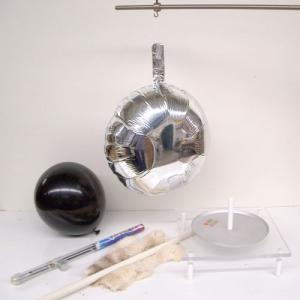College of Liberal Arts & Sciences
5A40.15 - Induction - Mylar Balloon
Hang a Mylar balloon from a rod and touch a charged rod to it. Keeping the rod in contact with the balloon, touch the back side of the balloon with your finger. Remove your finger from the balloon and THEN remove the rod contact. The Mylar balloon will now have a charge that is opposite of the charge on the rod. In essence, the Mylar balloon is just a large metal coated pith ball.
The Electrophorus or a regular balloon may be substituted for the rod in times of high humidity or when larger amounts of charge are desired to be transferred to the Mylar balloon.
- Borislaw Bilash II, David Maiullo, "Charge It Up", A Demo a Day: A Year of Physics Demonstrations, p. 240.
Disclaimer: These demonstrations are provided only for illustrative use by persons affiliated with The University of Iowa and only under the direction of a trained instructor or physicist. The University of Iowa is not responsible for demonstrations performed by those using their own equipment or who choose to use this reference material for their own purpose. The demonstrations included here are within the public domain and can be found in materials contained in libraries, bookstores, and through electronic sources. Performing all or any portion of any of these demonstrations, with or without revisions not depicted here entails inherent risks. These risks include, without limitation, bodily injury (and possibly death), including risks to health that may be temporary or permanent and that may exacerbate a pre-existing medical condition; and property loss or damage. Anyone performing any part of these demonstrations, even with revisions, knowingly and voluntarily assumes all risks associated with them.
